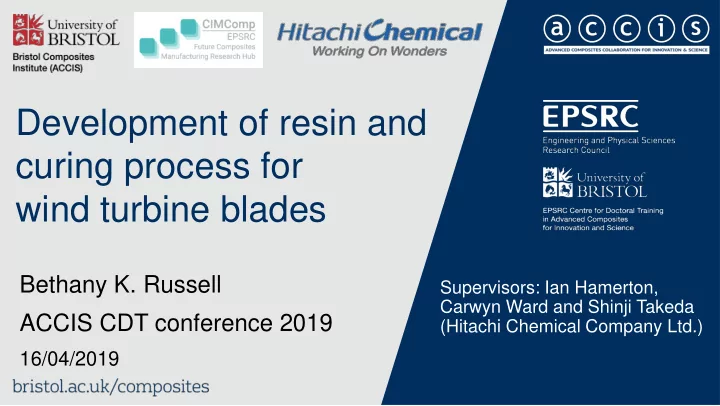

Development of resin and curing process for wind turbine blades Bethany K. Russell Supervisors: Ian Hamerton, Carwyn Ward and Shinji Takeda ACCIS CDT conference 2019 (Hitachi Chemical Company Ltd.) 16/04/2019
2 Project outline Optimised resin and cure process for wind turbine blade applications. Three-pronged approach: Novel anhydride- Interface Vascular curing- cured epoxies between resin optimise cure characterised and fibre CDT conference 2019
3 Resins • Within the project 3 anhydride-cured epoxy 1 resin blends have been characterised • Assessed the affect of anhydride structure on the resin properties 2 • Benchmarked against industry standard • Properties assessed include: T g , modulus, thermal degradation, rheology, cure 3 kinetics. CDT conference 2019
4 Interlaminar properties • GFRP laminates produced • HCCL resin showed improved ILSS (though a less toughened response) 5000 4000 Force / N 3000 2000 Anhydride-cured epoxy resin 1000 Resin ILSS (MPa) Industry benchmark 0 1 66 0 0.5 1 1.5 2 2.5 Industry benchmark 55 Displacement / mm CDT conference 2019
5 Interfacial properties • Microbond test procedure developed 0.25 1 Elastic behaviour 3 0.2 Interfacial debonding 2 Force / N Complete debonding 3 Resin IFSS (MPa) 0.15 4 2 Residual friction forces 0.1 1 35 2 32 0.05 4 1 3 27 0 0 0.5 1 1.5 Industry benchmark - Displacement (mm) CDT conference 2019
6 Vascular curing • Manufacturing of thick composite parts • Variation in cure profile -thermal gradients through thick composite sections -> residual stresses • Thermal gradients caused by temperature lags & spikes • Residual stresses -> warpage, cracks and delamination • Previous study modelled vascules 1 • Improved homogeneity of cure • Potential for multi-functionality 1. M. O’Donnell et al.: Cure rate tailoring of thick composites via temperature controlled vascular pathways, conference proceed ings: 57th AIAA/ASCE/AHS/ASC Struct. Struct. Dyn. Mater. Conf. AIAA SciTech Forum, (AIAA 2016-0161), 2016. CDT conference 2019
7 Conclusions & Future Work • Anhydride resins have improved ILSS and IFSS • Vascular cure shows promising preliminary results Future work: • Industry is moving toward carbon fibre systems. Work is ongoing to assess IFSS of resin on carbon. • Vascular curing • Trial of vascular curing in 50 mm laminates is ongoing. • Assess the model against the experimental results • Optimised cure of more complex geometries CDT conference 2019
8 Acknowledgements • The authors would like to acknowledge Hitachi Chemical Company Ltd and CIMComp Hub for their continued support in the project • Additional thanks to Dr Yusuf Madhik and Dr Matthew O’Donnell for their help with vascular cure modelling. • Further thanks to final year project students Hari Jones and Sarah Azamtu who have assisted in this work. CDT conference 2019
Thank you for listening Bethany Russell beth.russell@bristol.ac.uk
Recommend
More recommend